Dear Laurel,
While reading this informative article (several times), I became entranced by the window treatments, especially the curtain and drapery hardware. Would you please consider doing a blog post on the hardware required for a professional-looking installation?
Also, what is the difference between curtains and draperies? And, is there a difference between draperies and drapes?
I appreciate all you do Laurel.
Emilia
Thank you, Emilia.
Yes, I am in the process of moving, and yes, the renovation is starting this Monday!
Some of the information about curtain and drapery hardware is in this old post about window treatments.
However, I would like to explore this important topic more deeply. There is even more information in the 333 Decorating Rules & Tips, you need to Know guide.
And, of course, we will also go over some things to avoid doing.
Re: the difference between draperies, drapes, and curtains.
Thanks, great questions. As far as I’m concerned, the terms are interchangeable. Most people think of curtains as being more casual and lighter in weight.
So, whether you say curtains, drapes, or draperies, let’s dive into the basics of the hardware that holds the drapes up.
Early in my career, in the mid to late 90s, I did wooden rods for clients. However, I began seeing wrought iron rods done by all of my favorite design idols, like Victoria Hagan.
Great, because:
- I loved, and still do the wrought iron rods.
- In addition, fine wooden drapery rods were hideously expensive. I once joked with a client that she had a choice of a baby grand piano or drapery rods. haha
Therefore, I will only stick with iron rods for this post about drapery hardware.
Incidentally, I didn’t know until several years ago, but what is commonly referred to as “wrought iron” is actually steel. I learned that years ago from a lovely company, By Hammer By Hand, who made all of my custom wrought iron (steel) rods and more!
They were local to me when I lived in northern Westchester County, NY. However, they ship all over the country. Plus, their prices are very reasonable for custom work.

Above is pretty much all I’ve ever used in the way of drapery hardware.
This consists of a rod and a straight pipe made of metal and then painted either in a soft black or antique gold.
- Brackets to hold up the rod
- Decorative finials for the ends
- Rings (with hooks) to hold up the draperies or curtains.
Let’s Begin our Drapery Hardware topic with Curtain Rods.
The rods you will most commonly find are 1″, 3/4″, or 5/8″ in diameter. The rods I did were either 3/4″ or 5/8″. That way, I could easily use a 1″ (opening) ring.
What about the telescoping rods? (adjustable rods) Some of you may already know that I am not a fan, and here’s why:
Back in 1999, I had a client on a strict budget. So, we did the adjustable rods. Because one end is wider than the other, we spent two hours trying to get the curtains to hang straight.(ish) After that nightmare evening, I said, “Never again.”
Still, it isn’t the end of the world if that’s all your budget will allow. Please understand that everything I’m recommending is optimal situations.
In addition, an uneven hanging issue can occur with custom rods, too. The possible reasons for this unfortunate result are because of the following:
- floor is uneven
- window is crooked
- ceiling is crooked
- Everything is crooked and uneven.
I have a hard and fast rule in interior design, especially with curtain rods.

I recommend putting that one up last if there needs to be a center bracket.
Hang the rod without the center bracket and then have the installer hold the center bracket until the rod is no longer sagging but also not arching upwards. He will then put a pencil mark in the holes where the screws are going, and that is where he’ll drill his holes.
What if the rod is still sagging, and you can’t drill a hole because it is too close to the one already there? OR, the hole will show?
Ahhh… well, you DO have a problem. If it’s for a client, here’s what I suggest.
First, go to where they keep their booze and pour yourself a stiff shot (or two) of whiskey. ;] ;] ;]
Sure, go ahead and laugh. However, everything I’m writing about has happened to me, and sometimes on more than one occasion. I can guarantee it’s stressful as hell.
Okay, this is one of my favorite tricks; if you don’t want to or can’t make another hole, you can put a small piece of foam or something of that nature between the rod and the bracket it’s sitting on. This will raise it up some, and it won’t be noticeable. Nothing worse than a drapery rod that’s sagging in the middle, AND also supported by a bracket.
Okay, what if holes in the wall are showing, anyway.
Please try not to do that. I worked with one installer on several jobs and lickety-split; he had put up the brackets before I could stand back and say, “Doug, ummm, the rod is crooked.”
Naturally, I got tired of this (and my clients complaining) and, thus, replaced him.
However, even with the most careful installer, mistakes are very easy to make. This is why your clients MUST go for a protracted, deluxe spa treatment while you’re putting up the drapery hardware and window treatments. ;]
Really, unless they are the super chill type, they should not be home. It is for the same reason that you can’t be in the operating room if your child is having surgery performed.
So, now you have holes in your client’s walls.
After you’ve drunk the whiskey, you need to pray that somewhere, in the garage, basement, attic, closet– SOMEWHERE lives a left-over can of paint to match the current wall color. Your installer should always carry spackle with him in his tool kit. Have him fill the hole ASAP. Go find a hair dryer. Stand there like a nerd blowing the spackle dry. Dab the paint on very carefully.
Do not get paint on the window treatment. lol
Definitely, do not knock the paint can over. (Make sure the dog is nowhere nearby, as well.)
Carefully put the lid back on– tightly and put the can and hair dryer back where you found them.
End of story.
Hopefully.
Getting back to the rods. Yes, we are still only on the rods
If the expanse of the wall is more than eight feet, I recommend using the 3/4″ rod with a center bracket.
What matters is how the bracket gets attached to the wall. Of course, optimally, the rods will be screwed into a piece of wood known as a stud. Right? Well, if it’s a home built in the last 30 years or so, good luck with that one.
My experience is that new homes are typically made primarily out of cardboard and glue. This is not conducive to holding a metal rod with a ten-pound curtain hanging from it, along with an eight-year-old who’s using the curtain as a fortress.
Butterfly screws are your best friend, and while trickier to install will usually do the job.
In the 20 years I was taking clients, I went to every window treatment installation. And, whenever it was finished, it was an incredible relief! There are so many things that can go wrong!
If you’re a designer and you find an installer who does a great job, I would treat him (or her) like gold. They are not easy to find.
I’ve never gotten into anything fancy regarding twists and other unusual shapes for the decorative curtain rods. Just a plain pipe.
However, about 20 years ago, I began to see a lot of rods that had a return back into the wall. In other words, the rods curve back on themselves and go straight into the wall. The most sleek ones look like they are growing straight out of the wall. But, of course, they are well anchored into the wall, just as the straight pipe is.
The pipe can either be curved or at a sharp right angle, but it’s most commonly just a curve. These are called either return rods or French return rods.
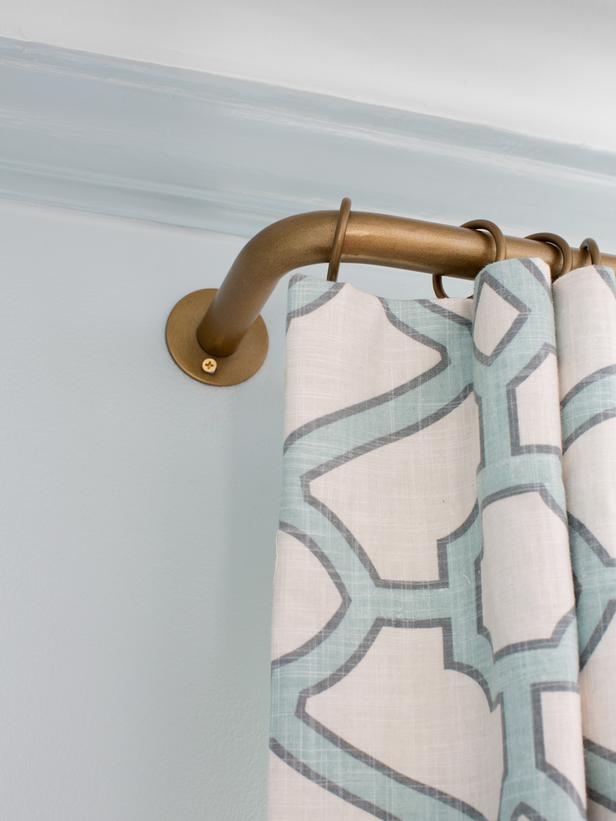
If the rod is a straight rod, you usually need a finial unless you are doing a rod with a self-cap.
You rarely see it, so I wouldn’t get too hung up about that detail.
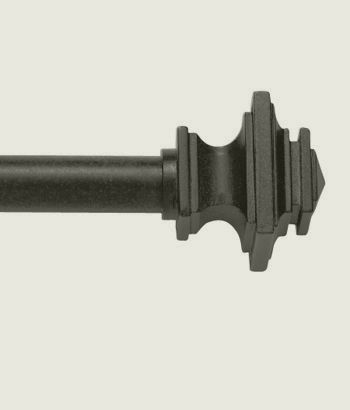
However, above is my favorite finial, which we fondly called the pagoda finial. Of course, you can do a plain ball, an acorn, whatever you like.
Drapery Hardware: Brackets
Brackets, of course are the supports that hold up the rod. And, there are many, many kinds to choose from. Generally, the simpler, the better. You can read more about them in this post. There are so many to choose from, but the ones I generally did are in the graphic above.
More about brackets later on.
Drapery Hardware: Rings
Okay, a basic ring should have a loop on one end. Then, you will need a steel drapery pin that attaches to the drape and hooks into the loop.
The pin must be placed so you cannot see the loop when the drapery is hanging. This takes a little practice, but eventually, figuring out the placement is not difficult.
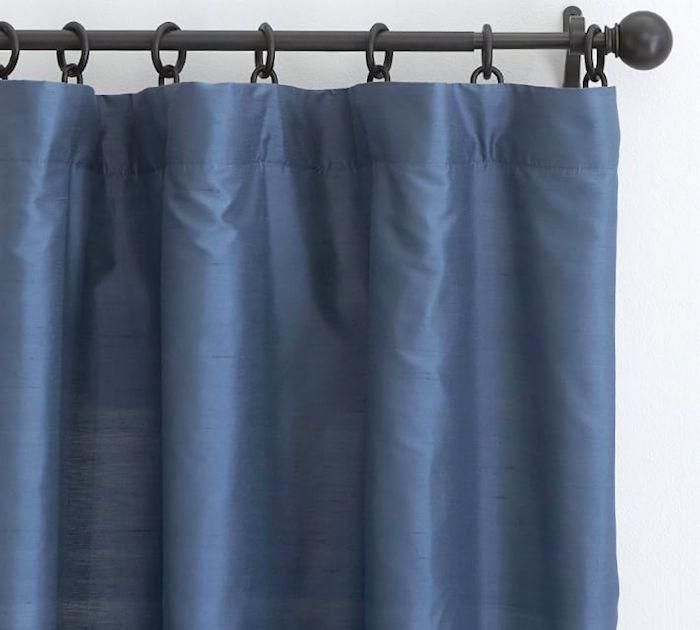
I love Pottery Barn. I like their ready-made curtains like this lovely silk dupioni. But, those rings! The bottom loop should not be seen unless absolutely necessary because that’s the length you need. Imagine if it was pulled out all of the way. This isn’t the best solution. The pin should’ve been placed about a 1/2″ lower.
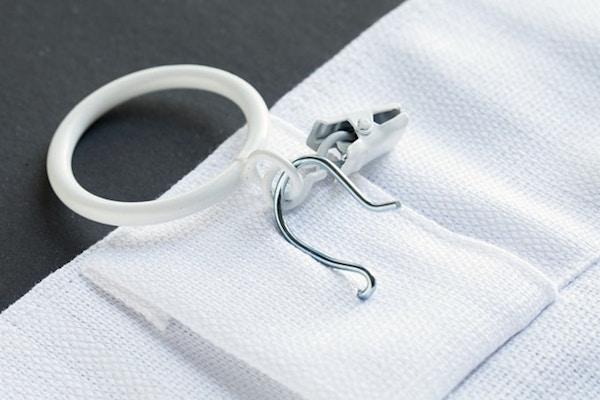
I have never understood the ring with a clip. Who wants to see an ugly clip? I guess it’s for people who can’t be bothered to use a drapery pin.
The one above has a loop and a clip. I guess no one will see the clip, in this case, since they are using a pin. Yes, the pin is correct.
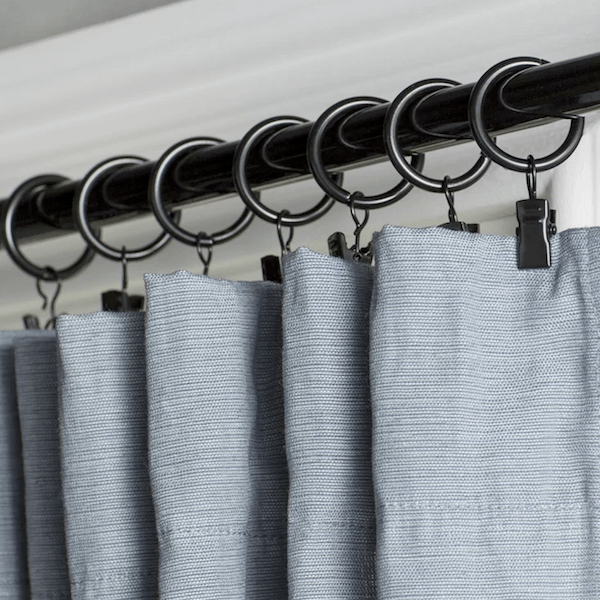
See what I mean? It’s like beetles are holding up the curtains. So bad.
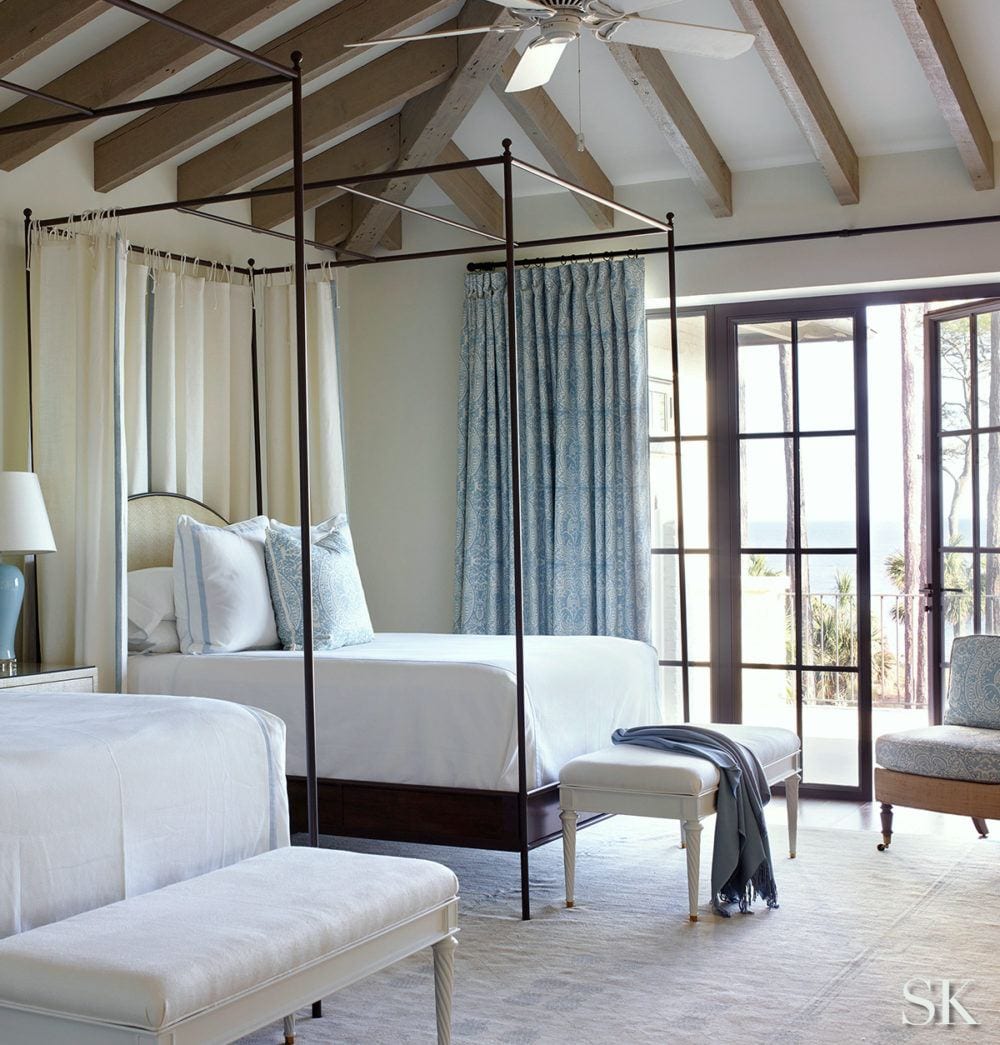
Above another exquisite room by Suzanne Kasler. See, you hardly even notice the bracket in the center of the rod. The draperies are beautiful and cover up the loop at the bottom of the ring.
This image should go in the post about grown-up twin beds, right?
For more about rings and clips, please check out this post with great information.
Frequently Asked Drapery Hardware + questions and problems.
Well, why do you need rings at all, Laurel?
That’s a great question.
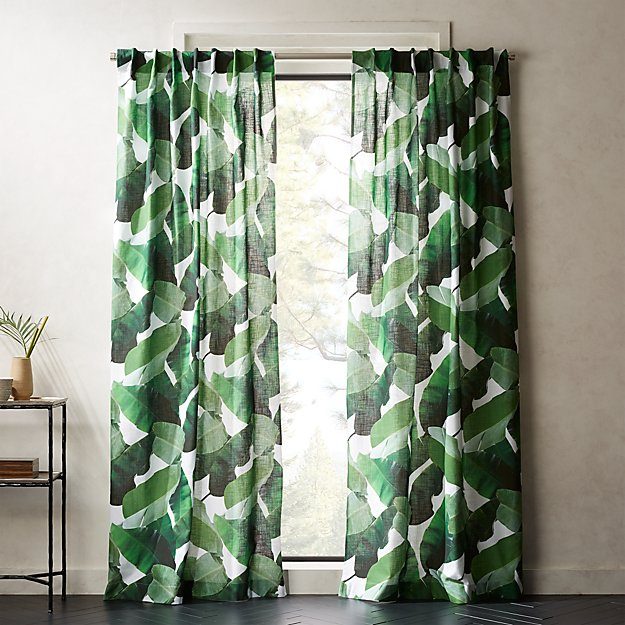
First of all, THIS looks bloody dumb, IMO.
It is very strange to have the drape covering a decorative rod. I never saw this done until maybe 15 years ago. In addition, please note that they hung the drape below the window casing. They did it because of the ready-made length. They always make an 84″ length; the next length is 96″. Someone should get wise and make a 90″ length.
Alas, I think it started when all the ready-made curtains became popular.
Ready-mades are a great solution when one can’t afford custom. But, rings are just one more expense. Perhaps, the likes of Pottery Barn and West Elm realize that they can sell more window treatments if they don’t also have to sell them the rings, as well.
But, have you ever tried to scoot fabric along a metal rod?
If you have, you will know exactly what I’m talking about. It’s very similar to trying to squeeze into your tightest jeans on January 2nd.
But worse.
Every time you try to open and close the drapes, you will be met with the most resistance you’ve ever known since your kids were five, and you said that it was too close to dinner time to get ice cream while dragging them out of the amusement park.
And, that goes for tab-top curtains too.
Sooooo, if you know that you will never open and close the curtains, then I guess you could go without rings. But, it is not a professional look. It is fine to disagree with me. But show me when Suzanne Kasler, Bunny Williams, or Victoria Hagan does drapes gathered around the drapery rod.
They don’t ever do that.
Still… if it’s temporary, you’re broke, and you need something cheap, then, of course, it’s absolutely fine to do everything I’m saying not to do.
In fact, I’ve considered doing something like that for my new rental. Although, I have plenty of rings left over that are now in my storage closet.
Speaking of rings, another trick to make the drapes open and close super easily is to rub a little soap along the top of the rod. You can also use silicone, but never spray directly on the rod, and wipe it on outside. I never tried it, but a little beeswax from a candle would most likely work, too.

via Traditional Home (no longer being published) ;[
Another beauty from Suzanne Kasler. Exquisite. That looks to be either a 3/4 or one-inch rod. The draperies are full. The header is covering the loop on the ring, and they are breaking about an inch or two on the floor.
Laurel, aren’t they worried about the draperies getting dirty?
Not at all. They are too busy worrying about their kids getting into Princeton, Harvard, Yale…
However, if you need/want to save money and have a working curtain without rings, I think a grommet curtain is fine for a casual look.
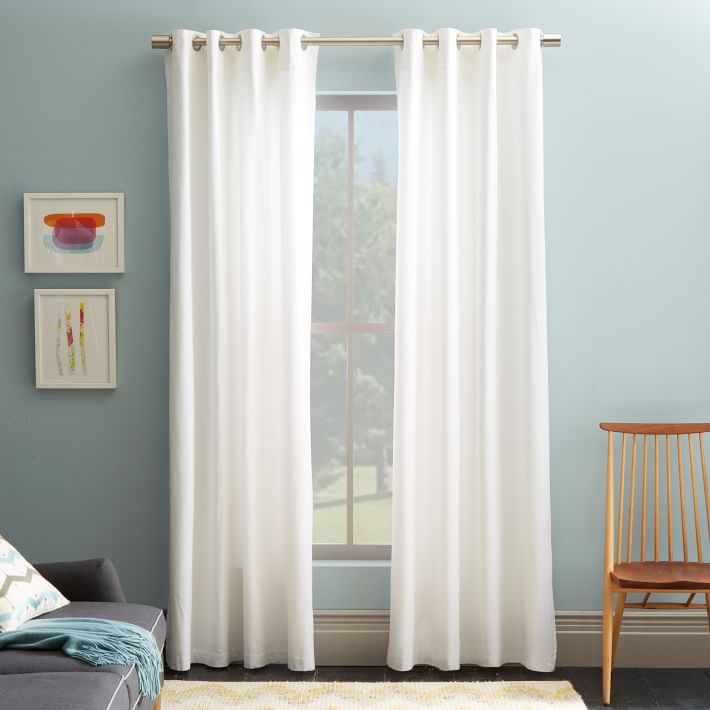
This white canvas from West Elm is inexpensive and nice looking for a more casual interior.
One of my favorite posts is how to make budget window treatments look expensive.
Laurel, what’s that funny-looking ring that looks like someone took a bite out of it?
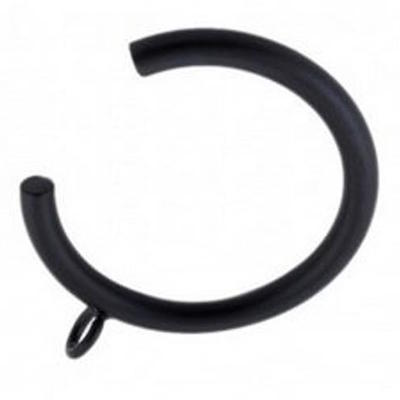
Ahhhh… that’s called a “C ring” for obvious reasons. The one above is from a boutique custom-drapery hardware company on Etsy called Lilly Max Decor.
What’s it for?
It’s for when you have a long decorative bracket that requires more than three brackets.
Normal rings won’t be able to go past the extra brackets. Therefore, some of the rings will need to be able to pass by those two brackets.
Or, sometimes, the curtains might need to open to one side or the other, and there’s one center bracket to contend with.
Can you purchase rings and rods from different places?
Yes, you can. And what if the finish doesn’t match? If it’s already hand-painted, you can adjust the rod a little with some craft paint. But, unless the match is several shades off, it won’t be noticeable. I know this from experience.
Laurel, you haven’t talked about tie-backs.
You’re right. I haven’t. They’re lovely in a grand old home with 10-foot-high floor-to-ceiling windows. But, they’re a bloody pain in the arse. I always did holdbacks instead of ties.
One last question, Laurel, about the drapery hardware
Okay, fire away.
How do you know how high to hang the rod? Or rather, how do you know how long the draperies should be?
Oh, this is such a great question. There is usually some wiggle room, especially if it’s okay with you or your client if the curtains can break on the floor. I said break, not puddle. Nobody does that any longer. By break, I mean at most an inch hitting the floor.
But, this is where it is advisable to know what curtain hardware you’re using before you order your curtains. Once you know that, all you need to do is figure out how high your rod should be and allow space for the rod and rings. It’s usually about the overall diameter of the ring.
So, if your rod is at 92″ off of the floor and you’d like your drapes to break slightly, they should be about 91″ long. If you don’t want the break, then about 90″ should be good. But, always double if not triple-check!
Below is a mini widget with some of the products we’ve discussed and terrific sources for drapery hardware.

Okay, I am quite positive that I have not covered everything.
It’s a surprisingly broad topic!
You might also enjoy this post about different drapery styles shown in 17th – 19th-century art.
But, have you seen these so-called easy-to-install brackets? They don’t put ANY holes in the wall.
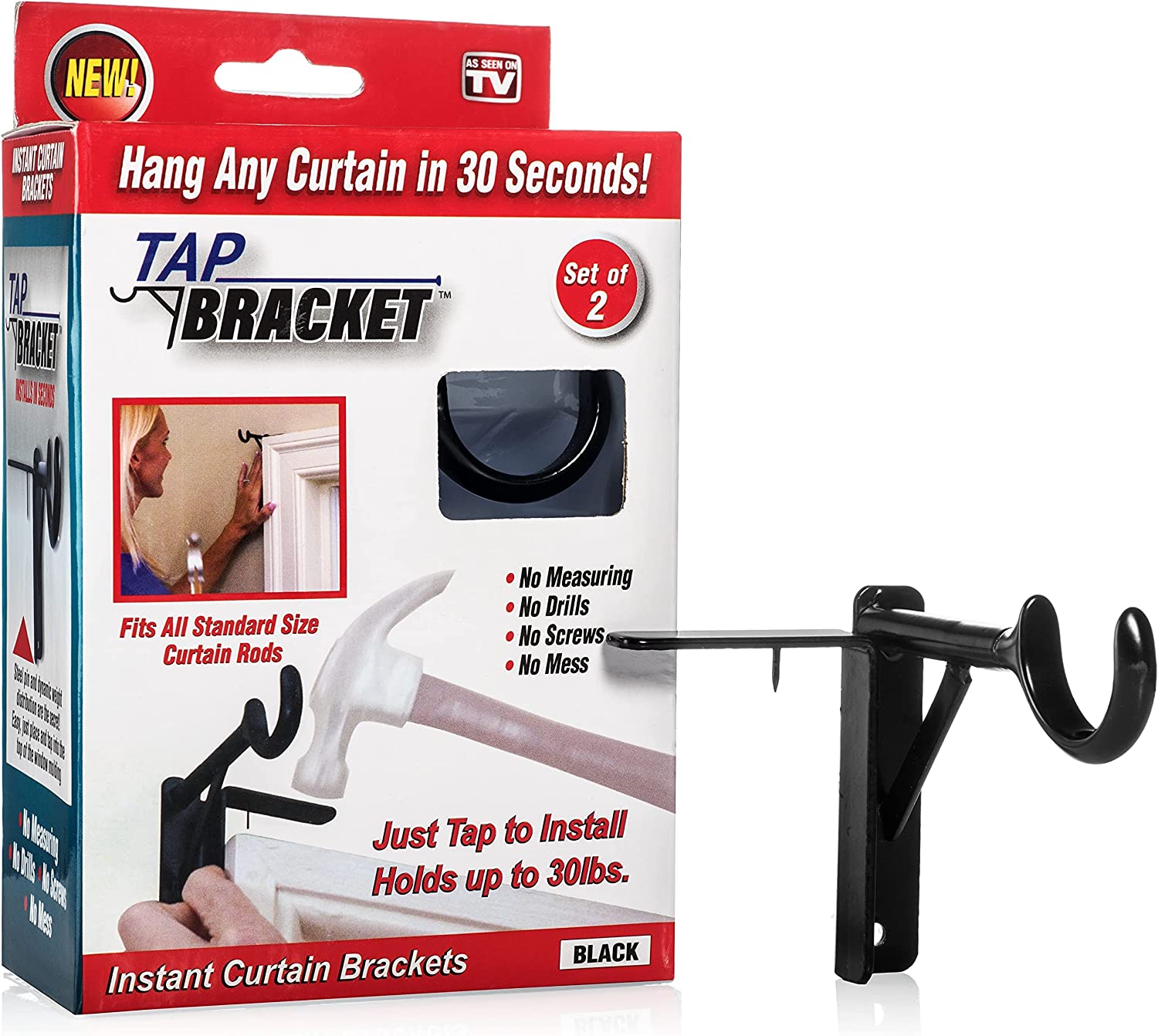
They’re called Tap Bracket. (You can see them here.)
They claim that anyone can hang curtains in 30 seconds or less!
Really?
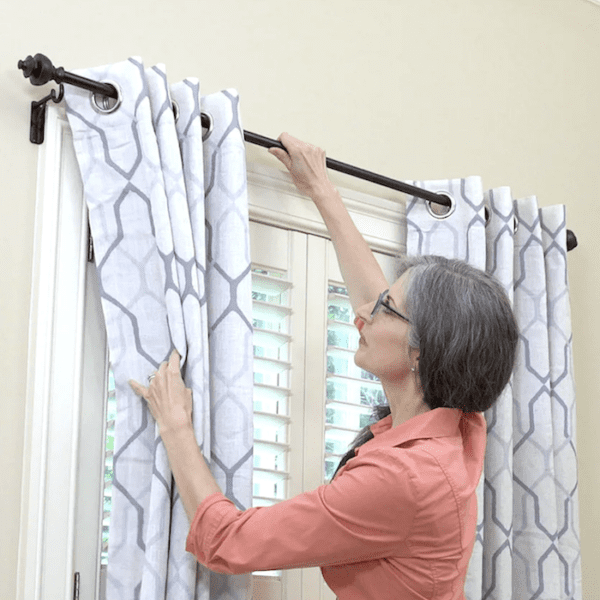
Below is a video that tests them to see if they really work.
Well, I’ll be. I would love to put these up in my new rental. The only problem is that the top of the window moulding is about two inches from the ceiling. I know, very unusual. It would not be easy to get a hammer in there.
Please read about the Best Bay Window Treatments and Measuring Guide.
Okay, gotta finish packing! I hope you enjoyed this post about drapery hardware!
xo,

PS: Please check out the newly updated HOT SALES and the newly updated gift guide for Father’s Day!
Related Posts
 Are Green and White Rooms Trendy or Passé?
Are Green and White Rooms Trendy or Passé? Everything You Need To Know About Classic Woven Wood Blinds
Everything You Need To Know About Classic Woven Wood Blinds 21 Common and Hideous Interior Design Mistakes
21 Common and Hideous Interior Design Mistakes The Horrid Gray Trend – Is It Finally Over?
The Horrid Gray Trend – Is It Finally Over? The Best Upholstery Fabrics For Pets and Slobs
The Best Upholstery Fabrics For Pets and Slobs The Magnificent Front Doors of Beacon Hill
The Magnificent Front Doors of Beacon Hill How To Avoid the Clash of Formal and Casual Furnishings
How To Avoid the Clash of Formal and Casual Furnishings










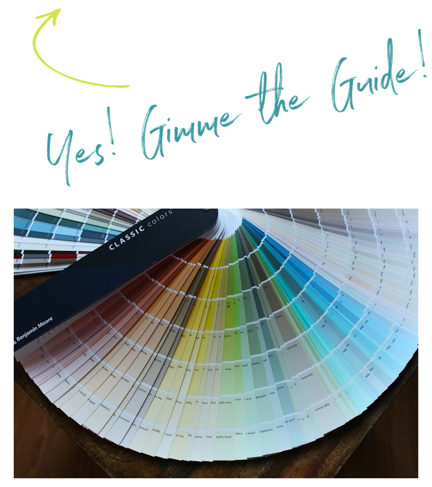
102 Responses
I recently lived in SF but my long time decorator friend was in NJ. We selected the fabrics together, I measured, then she had my drapes done at her workroom but then I had no one to install on 10 ft high windows. Called my local Calico Corner shop and made an appointment with a very nice sales woman there. I brought the fabric samples and she worked with me to select the hardware (beautiful custom but not outrageous) and she gave me the name and # of their local installer. He was not only very good and reasonable, but just came back 4 yrs later when I was moving again to take everything down for me! A gem and a gentleman.
Hi Kathleen,
What a great story! Thanks for sharing. I’ve worked with some fantastic installers, and they’re invaluable!
Hi,
Love your blog. Is it too much to have solar shades for windows in family room. And roman shades on a kitchen window and romans and curtains for dining room. I have an open floor plan.
Thank you so much
Hi Ilene,
Thank you! Without seeing what you’re talking about, it’s impossible to know.
I Laurel.
Love all this info. I am, however, waiting to see your decorated closet as it sounds to be a reprieve from all the moving and “waiting” for your true reveal at your hopefully “forever” home. Stay strong Laurel and know the road ahead is paved with good outcomes and challenges. As we know, the challenges are what make us grow.
We are all here (and hear) for you.
Be advised, if store bought draperies are being shortened, please do not take them to be altered and say, for example, shorten these 4 inches. Both panels rarely match in length, and almost always, one side of the panel will differ from the other. It does not matter the price point, either.
This comes from a retired seamstress that has experienced this headache.
I’ve made my own drapes numerous times and I can tell you that no matter how much you are charged for custom drapery, it isn’t enough. It is bloody hard work from start to finish. My first set of 6 were lined and of a very expensive Kravet fabric that looked like dupioni silk. I have a very small sewing room and managing yards and yards of fabric is not easy or fun when you don’t have the 10′ x 6′ foot work table that most workrooms use. My last experience was with linen that was so heavy I couldn’t even think of lining them because carrying just one unlined drape was backbreaking. Calculating yardage involves more math than most adults will face in their lifetime and has caused many a prospective sewist to throw up her hands and say “forget it”. I like math but figuring out finished length has always involved several trials because after hanging, the drapes usually grow by an inch or two which has left me in tears more times than I can count. My advice is to thank your lucky stars if you have someone to guide you (like Laurel) or to make them for you.
I don’t think it is a serious grammatical error, but to save someone possible embarrassment the difference between drape and drapery is drape is a verb, drapery the noun. The fabric you chose drapes beautifully and will be elegant draperies. I was severely chastised by my mother-in-law – over a century ago, when I complimented her on the beautiful drapes in her living room. There are some rules of grammar you just never forget!! No matter how unimportant.
jeanne
First, I hate grommet drapery with the heat of 1000 suns. But that’s me. I also have no problem with clip rings in a more casual room. Lastly, Traditional Home is most certainly still being published -it is now a quarterly to which I subscribe.
Thank you for another fabulous post, Laurel. Sometimes when the news is bleak I return to some favorite posts and enter a happier state of mind. Making the world a beautiful place is really what matters and you are a genius in inspiring your readers with the details of how to make that happen.
I know you don’t love tab curtains, but have you seen Carolyne Roehm’s tabbed curtains in her Charleston house? They are fixed and quite formal – gorgeous fabric and ties/bows securing each tab. Rather stunning.
Good luck with your move – can’t wait to see the unveiling!
Terry
Thank you, thank you for all of the details! I have a question about cafe curtains… I grew up with them in the kitchen am and seeing them again. They might be perfect for my one kitchen window, in a sheer white, with pleats. What do you think? A fad???
We have traverse rods for linen curtains on two large banks of windows. They look good open and closed. Much easier than the wands we have for similar curtains in another room. Sometimes I don’t get those opened evenly.
Custom curtains are beautiful and worth the expense. But it can be hard to find a workroom, for amateurs like me, working without a decorator. Let me put in a plug for The Shade Store. Not inexpensive, but they do beautiful work and have great service. Had some issues with a Roman shade, purchased from them seven years ago. They sent a repair person to my house within days. No charge to fix.
Thanks for your reply!
Hello! Thanks for all the wonderful information you share on your blog. I have a question about curtain/drapery hardware in bathrooms. Should the window curtain rod match the finish of the shower curtain rod? Thanks for taking the time to read my question.
It depends. Sorry, there are too many variables. Over-all, I would say no, it does not have to match, but in the context of the design, that should make sense.
Travis, as Laurel said your drapery should overlap in the middle, even with a center bracket. You may be able to move the drapery pins in to create a small overlap. The best choice for drapery hardware for a functional treatment (especially a heavy one like velvet), is a Decorative Traverse Rod. But you are not out of luck. There is a tape that you can put on top of the rod, although I’ve never used it, so can’t speak to it’s usefulness. You have 2 other options. Take some Pledge and spray it on a rag, then rub it along the the top of the rod. This works really well for Wood Rods. If you have a Metal Rod, get some liquid silicone and do the same thing – spray on rag and rub all along the top of the rod. Do NOT spray anything directly on the rod, because you might accidentally get it on the draperies. You do not want that! Good luck! I bet your velvet draperies are beautiful!
Maybe it’s just me…. guests complaining about curtains and getting adamant that the installation is the problem?? Yikes.
Hi Laurel! Thanks for all the great information regarding getting your draperies installed correctly. I do have a few other questions that I am curious about. Is it acceptable for an expensive drapery install to have a small gap between the two panels of drapery where they meet up in the center with or without a center support bracket? Is this unavoidable? For heavy drapery with blackout lining have you ever used the tape that goes on the top of the rod to make the heavy drapery slide more easily? I had guests recently who were complaining that they couldn’t close the draperies completely and that the rings slid too sluggishly over the drapery rod. They were adamant that the installation was a problem. For the record, I picked the fabric, the lining, and the French return rod so a big part of the problem may have been my choices! The drapery wand is rather heavy and not infrequently comes off because you end up lifting up on the draperies slightly to get them to slide more easily. Those are my drapery issues and perhaps they are unavoidable? I am hesitant to contact the installer because open and closed the draperies look beautiful and I figure that perhaps this an issue with all heavy draperies and unavoidable?! You always have great advice and of course if this is off topic please don’t feel you have to even respond or post the question! Always greatly appreciate all your advice and wisdom from the world of design.
The draperies should not only meet up, but actually overlap by a few inches. I have not heard of the tape you’re speaking of, however.
Laurel , I have read every curtain post and realize how foolish I was to think I was going to hang curtains in my home. My problem now is a window with a radiator directly below it. I have no idea how to dress it!
Roman Shades are what I usually do in cases like this.
First of all, I could never hate you! That being said, thank you for sharing the pictures; the rods look great in this application. I’m noticing that lucite rods look best when there is a very pretty paint or wallpaper showing through them — they have the ability to almost disappear.
You’re welcome Patti! I can’t see what what said before because I’m in the answer comments area of my admin dashboard.
Hi Laurel,
Well, now I’ve learned something new. I had never heard of a C ring before. I can certainly see how functional they could be.
Does anyone ever use a traverse rod anymore? I remember when I was younger having one above some sliding glass doors. And I would pull a cord that was along the side of the window treatments to open & close them. It allowed you to open & close your draperies without needing to touch the fabric.
Hi Mary,
Yes, they make them, both the decorative kind and the kind that you don’t see. I used those once or twice if we did a valance.
I made and installed all of my own drapes (I swear they are nice, lined and interlined, euro pleats but they just kiss the floor because I am also the maid), and I actually ordered wood kirsch rods online partly so I could easily cut them to length (just need a hand saw). Our house is extremely crooked which will be charming in 75-100 years, and I actually installed the hardware first and then measured for the drapes. There is one window where the right panel is a full 1/2 inch longer. A good option maybe for DIY-ers. I am still totally stunned by how expensive the curtains in our house were considering I bought all the fabric from online discounters and I sewed and installed everything myself. I have convinced a few friends that their outrageous curtain quotes are not a rip off. Anyway your other curtain posts were extremely helpful for understanding pleat types and widths, thank you!
Hi Catherine,
It’s true. Nobody is getting rich off of window treatments. At least, I don’t think so.
Thank you for all of the really great info in one post! I tend to call short draperies “curtains,” but I can see the light vs. heavy. Or maybe lined vs. unlined. I love the French return rod! When I have used the cheap expanding rod, I buy 2 of them and use the two large ends with one skinny in the middle. That way you only have a small amount of the skinny rod in play and can easily adjust the center support to hold it. But the majority of the drapery panels will be on the same diameter rod. Thanks again for this great post!
Yes! Thanks for giving that info on the return. It makes such a difference.
Such an informative post! How do you recommend choosing the hardware finish/color? Should you consider the color of the room or the style of the room?
Hi Maureen,
Good question. It’s too many factors, but most of the time, I did a soft black. But, sometimes if I wanted a lighter or more formal look, we did antique gold.
Amazing topic and research, in my list of your hits! My favorite blog post is designers you would like to hire. And anything about decorators from hell or clients from hell. I’d love to read fresh versions of them. I know that is not safe topics for the writer, but I injoy reading them as a reader and find them so educational, fun and just great! Personally, I’m interested in a topic such as why A-list decorators think they’re so unique and charge $$$, what do they bring to the table? They all shop at the same sources all the time. And why decorators never have the list of services on their websites? I guess when they come to nail salon, they would demand it. Or at a restaurant too. It immediately make them look a bit dishonest. Like they’re hiding something. And they ask what is your budget immediately… like come to nail salon and depending of what clothes you wear we charge you accordingly. The same time MRI in a hospital costs… you know how much and no one is complaining that it’s a rip off. lol
Hi Lisa,
There are fresh versions of the decorator/clients from hell posts and they are all next to each other. Definitely within the last year.
OMG, what a comment I posted. I just read it;] Laurel, please forgive me. But your answer is great anyway!
In high school and college I worked for a lady who had a drapery workroom. She went bonkers if someone said “drapes” instead of “draperies”. She explained that “draperies” is a noun, and “drapes” is a verb. Lest her ghost should reprimand me some 40 years later, I use them correctly to this day!
Oh, too funny Gail. Well, in this day and age where every verb has turned into a noun anyway. (And vice versa) I mean if you GOOGLE it, I think that we can ARCHITECT a solution before the big REVEAL.
And, there ARE words that are both nouns and verbs. EScort, esCORT IMpact, imPACT INcrease, inCREASE INsult, inSULT – I looked that up. I’m not that clever.
Therefore, I wouldn’t GUILT yourself too much over the use of drapes instead of draperies.
This is the best and the most in-depth post about drapery hardware I’ve ever seen! Laurel, I’m wondering if you doing your own interior design and want some help…say from another famous designer (for example, Suzanne Kasler), would it be acceptable for another designer to work with you? Do designers work that way or they prefer a regular client? In terms of fees, how would you ask someone like her?
Hi Val,
I’m not sure I’m understanding the question. Really, there should only be one head chef. Of course, I’ve consulted with designer friends on occasion. But, it’s a reciprocal thing. Or, we share sources. I have a friend that I met in design school back in 1988 and we used to do that all of the time. And, sometimes even send each other clients that were better suited (maybe) to the other. We had very different styles.
Some designers who are well connected might get the work and then hand it over to another designer and take a cut of the profit. How does that work? Well, of course, they are honest about it. It can only work if the two designers have the same aesthetic. That is different than hiring designers under your own umbrella.
I don’t know if that answered your question or not.
Hi, Laurel,
I have a question regarding grommet-topped curtains covering a long span with a rod requiring support brackets. What’s a girl to do? I have ready-made Pottery Barn Payton drapes spanning the entire length of my wall, which are driving me nuts because, predictably, they get hung up on the support brackets required by the length of the rod span. What would be the correct method of hanging a grommet-top drape over a long span? Should I surgically remove part of the grommets and drape so that they form a c-ring as required? Or, is this type of ready-made drape just not appropriate to a long span. 🙁 Hind-sight is 20/20, but I’m not planning a do-over. They look great when closed!
Hi Susan,
Well, I can’t see what your sitch is. I don’t think you could turn the grommet into a C-ring because it’s part of the fabric. With a C ring, the fabric is underneath the ring. The only other solution is to divide up the panels, so that none of them are required to cross over any of the brackets. But, again, I don’t know if that’s possible with your configuration.
Hi Laurel, I LOVE your blog, it is quite literally the best source for me on just about everything I come up against as a designer. Some stuff I learned the hard way, but so much better to learn from your experience!! One question I have: do you ever find that measuring length sometimes isn’t enough? I have found that, depending on fabric and length, ready-mades fabric can pull down a bit and screw up all your length measurements (most of my client’s kids go to community college). So I always have my installer hold up the drapes on the rod and bracket before marking the holes for the bracket screws (poor guy!) since I prefer hanging between 1/2 to 1 inch above the floor. Any better ideas rather than ruining my installer’s arms and good opinion of me? Amen on the extending rods!! Hate them, measuring is impossible, straight is impossible, can’t pull a ring over them, arrrggghhh!!
Hi Dee-Dee,
Well, when we are on site, we take one panel and lay it on the floor and then one of us takes one end of a front and the other takes the other end and we make sure it’s nice and taught, not pulling, just perfectly straight and then take our measurement. But, yes, sometimes, the brackets still didn’t end up in the right spot. And sometimes, it was in one of those “cardboard” houses. The sheetrock just crumbles away. No wood. No wood anywhere to be found!
But, we always got them up and secure. As far as I know, no rod ever came down unexpectedly. knock wood!
Any thoughts about hanging curtains from the ceiling? I know that Bobby McAlpine and his crowd do it all the time. I have a bedroom situation where we would like curtains but pockets for automated sun shades prevent us from hanging them on the wall.
Hi Annie,
I did it once with a rod. That one was difficult for the guys to install, but they did it. We used the bracket that has a loop and the rod was in two pieces which screwed together. It was quite dramatic because the ceiling was also quite high. I know that there are some posts here that show drapes hanging from a hospital track on the ceiling. So, to answer your question, yes, it’s possible.
This post illustrates exactly why I find even thinking about window treatments so difficult. They are sooooo complicated.
We rented a rustic house here in the mountains that had no window coverings. It mostly didn’t matter because neighbors were far away.
However, I tried to put up curtains in the living room and they looked awful with the strong rustic architecture in that room. The curtains actually muted the architecture! The minute we took them down, the room looked right again.
On the other hand, when I put curtains up in my bedroom, they improved the room amazingly.
Hi Lorri,
That’s interesting. For some jobs, there was a question whether window treatments were necessary. So, I would say, let’s do everything else and see how it is. It was about 50/50. One thing I tried to avoid is putting in window treatments before the other furniture came. Rooms tend to look funny with window coverings and nothing else in them.
I’ve used stitch witchery to hem ready made panels when we moved in. I needed something fast to create privacy and my sewing machine was buried somewhere in the garage. 3 years later I finally bought fabric to make something better. But the stitch witchery has not held up well over that time. It’s basically glue dots you steam, heat and use to seal your hem like an envelop. Well, every time you wash and dry the item you’re basically reheating and steaming the seal. If it goes through your drier it’s moving around while the glue is soft so your seam fails. I’m not sure how it will hold up to dry cleaning. It’s good for fast and dirty like kids Halloween costumes or things that don’t get washed like lavender sachets. You can use it in place of pins for long straight seams like curtain hems so you can run them straight through your machine without stopping to remove pins. But don’t use it in place of sewing on anything that needs regular washing.
Reading my mind again! I’ve been looking at drapery hardware this week. I just found the coolest company tonight with both Canadian and US online outlets. Order your rod longer than needed and cut to length. The finials slip onto the ends of the rod. presto – instant custom rod at a great price. draperycurtainrods(dot)ca or (dot)com. Nice rings too.
Hi Gail,
You can sometimes cut rods, but if they are heavy duty steel, it means a hack saw and a lot of elbow grease. My guy had to do that a couple of times and believe me, it’s not easy. I would avoid that, if possible. And, if these rods are easy to cut, it means that they might be too flimsy. I don’t know for sure, since I haven’t seen them.
Ususally one pin goes behind each pleat and also a pin on each end about a 3/4″ in. If you don’t want the “loop” of the ring to show above the drapes, I call it the “eye”, put the pin in so the top of the pin finishes about 1/2″ from the top when inserted. Adjust if necessary. The pins on the outer ends of each panel gets hooked, not on a ring, but a hook or screw eye mounted (properly!) in wall. This holds the drapery return (the flat section after the last pleat) perpendicular to the rod and wall and gives the draperies a nice custom finish as well as blocking light at the outer edges of your drapes. My business makes and installs custom drapes which gives me some cred!
Thanks so much Frances. I have put the pins in, but forgot how far they need to go down. And yes, there’s usually a little wiggle room. Maybe 1/4″-1/2″ Once or twice, we covered up a little more of the ring than I prefer, but the clients did not want the drapes dragging on the floor. (boo hoo) and I did not want to have to take six pairs of lined and interlined silk drapes back to the workroom and then back to Long Island where the job was. But, the client was very happy, in the end.
Hi Laurel! Thank you for another fabulous post! I have a question about the distance between the crown molding and the rod. We have 10 foot ceilings in our Victorian house. The bottom of our crown molding is only 2 inches above the top of our window trim. Is it still possible to hang curtains hanging from rods using rings?
Hi Sandy,
Yes, absolutely. The thing you need to watch out for are the brackets. Sometimes, they have a long vertical tail. So, I would avoid those. Even the ones with a disk might be problematic with only two inches to work with. The solution in either case, if this is possible is to do a rod at least 4 inches wider (in total) than the window. The brackets will go to the left and right of the upper window casing.
Of course, you can make your rod 12″ wider, if you’d like less glass showing. If the windows are very long and your rod is 48″ or more (not including a finial), I would probably make the panels one and a half widths. The exception would be if you’re using a very heavy fabric like a velvet.
“How do I “thank you” Let me count the ways.” Well I would be writing for a long time. So just let me say thank you for answering my question about the rod but for also covering all the other drapery questions swimming in my mind. I was especially pleased to read that you also liked drapes that skim the floor (not puddled). I dislike the look of drapes standing at attention like Praetorian Guards on either side of my sliding glass door so I was worried about how I was going to respond to the eventual criticisms that I was going to get when I installed drapes that skimmed the floor. I will move forward more confidently now. Thanks a million Laurel.
Hi Emilia,
I imagine when the A-listers have their clients sign their contracts, there’s a line in there about drapes being allowed to skim the floor. ;] They all do it. But, when one has hired the best, is there any arguing?
Thanks Laurel! Very helpful reply and link.
Dear Laurel,
I am remodeling my bathrooms. I was planning to do dark blue walls and gold mirror, sconces, knobs in the powder room. I spent hours looking at them online. The trouble is that there are a bunch of golds! French gold, champagne, satin brass, brushed brass, antique gold! I found a gold mirror that I really like and I am exchanging brushed brass sconces for polished nickel. I think the mirror will be the only gold, everything else is polished nickel. Is that acceptable? I am still liking at mirrors and I could put this one in my bedroom. Perhaps you already have done a post on gold colors and how to match or mix metals in a bathroom. If you haven’t, it might make for a good one.
Thanks for all of your posts. I always look for them on Wednesday and Sunday. They are like gifts from a friend!
Hi Heidi,
I think what you’re doing sounds lovely. Since I can’t see the entire space, I can’t say for sure if something could/should be gold or not. But a gold framed mirror goes with everything.
Thank you for your informative and finely illustrated articles over the many years. Is mid century modern furniture a topic you would address; it hearkens back to my childhood😃.
Hi Marcille,
Within some posts there is some mid-century furniture, I’m sure. I like a lot of it and like mixing it with contemporary styles. But, I probably won’t do a post specifically on that one style.
Hello Laurel, I have some beautiful antique curtain tiebacks that are worth collecting, but I don’t think that I would ever use them as I prefer the simplest window treatments.
That photo of the return rod with the blue strapwork curtain struck me as odd. The screw securing the flange of the rod was both crooked and protruding. The hole in the flange should have been counter-sunk to receive the head of the screw, as clearly seen in the return rod from Maison Lane that you also illustrate. Furthermore, real bronze screws are still available, and are not that expensive. Also, people with an eye for quality and tradition would not tolerate an exposed Phillips-head screw–I would certainly specify slotted ones. Perhaps this crude installation was just for a showroom and not in an actual house, but either way if I were paying thousands for window treatments I would not be too impressed with the level of workmanship. My eye would be riveted to that crooked, cheap screw. As the saying goes, the devil is in the details!
–Jim
Hi Jim,
It’s true. That isn’t the best example. But many of them have the fabric covering up the rod. And, I just wanted to convey the basic configuration of the rod. I’m also not a fan of the disk and prefer a stem that’s hidden. But, those are in the links in the widget.
In addition, the fabric on the curtain should also return to the wall.
Laurel,
This is a winner. Never thought of measuring from the ceiling and then from the floor. Putting that in the archives.
I, like Cindy above, have made most of my draperies. Some have been a success and others not so much. When I see beautiful draperies, custom of course, I smile. There is nothing like custom work and the skilled hands that make them.
That’s very true Barbara. Plus, they have the equipment and extra-long tables that most of us don’t have.
Three winters ago I made family room drapes out of striped Pottery Barn linen duvet covers. The backs of the duvet covers are plain cotton, serving as the already-in-place drapery lining. I wanted the fabric to just skim the floor, so I pinned the hems in place and then hand sewed them. Well…the length is perfect while the heat is on and the air in the house is dry, but in summer the humidity causes them to lengthen and break a little. It’s not a problem, but I thought I’d mention that it’s a good idea to be aware of humidity when working with loosely woven fabrics. I’m just glad I made the drapes in the winter, or I’d be looking at high-water window treatments half the year and grinding my teeth to nubbins.
Hi Kathy,
Yeah, we call that yo-yo-ing. Linen is notorious for doing that. And sometimes I’ve seen it where it raised up and got stuck in the 4″ off the floor length. Really bad. Lining should help keep the fabric stable, unless the face fabric and lining are both yo-yo-ing together.
Wonderful post and perfectly timed as I have been avoiding buying drapery rods because it just felt too intimidating. I just have one follow up question. Is there a general rule about the length of the rod as compared to the window? How much further past the end of the window should the rod extend?
Hi Rachel,
That’s a very good question. I think I covered it in one of the other posts I linked to. But, maybe not. The minimum that a rod should go past the window frame (casing) is one inch, not including the finial. If there’s no finial, but a flat cap, then I would do a minimum of 3 inches.
But, what’s also important to take into consideration is that the shorter the rod, the more glass will be covered when the curtains are open. That’s called the stack back. How much room does that take up? Well, it depends on how heavy the fabric is and how many inches wide is the curtain.
For instance, some windows are very long. Or, they might be French doors and your panel might be three widths or about 150″ of fabric that’s also usually pleated at the top.
The other thing is that you don’t want the rod to be too long so that some of the casing is showing behind the curtain/drape. That’s a big no/no. If your drapes are meant to close, that shouldn’t be a problem.
Sometimes, I made the rods longer, intentionally to make the window appear to be larger than it is. But, some windows are wider than they should be, so I made the rod only an inch or two wider than the window on each side.
One other trick is if a window is off- center. Sometimes, the rod can be placed off-center to make the window appear to be where it should’ve been. Difficult to explain without showing. This works best with blackout lining as the effect would be ruined if light were shining through some parts and not others asymmetrically.
But, under the most common circumstances, let’s say that the window with the casing is 40″, I would probably make the rod 48″ wide.
There’s more information in this post.
Amazing post! I learn so much from it! Just one question regarding English language I’m learning too. This phrase “They don’t do ever do that.” But “They don’t do that”… is same meaning? “Do ever do” is very symmetrical and looking great! I’m taking notes and will use this line.
Okay, incoming dumb question. I am guilty of using rings with clips and you’re right, they look bonkers. So I should use the pins. But what, on the curtain, do you stick the pins into? If you have ready-made curtains, do you need to sew some kind of tape on them into which you stick the pins? I’m completely lost here….
Hi Paula,
That’s not an absurd question. No, you don’t need to sew anything into them. If you look back at the header of the curtain, there is always a hem, just like on the bottom. If the curtains are lined, then you get an extra layer. You carefully put the pin there so that it catches one or two layers of fabric (if lined), but not all the way through, as of course, then the pin will show. Some fabrics are easier to pin than others. If you have a lot of pins to put in, your fingers will be screaming at you.
There are some tutorials and more information here.
Thank you for your expertise on Curtain and Drapery window hardware. Do you recall ever living in a place where you could not put up drapes, and were stuck with those plastic roller blinds which had a stick at the base to use to pull down the blind? They originally came with a plastic handle that was always gone so there was dirty smudges from people pulling the blind down. Oh the fun of renting:/ Those days are past now and I have lived in many homes since, I love having a home which allows me to put up, take down, blinds, no blinds whatever I wish :)So much enjoy reading your posts!
Now THAT is a very sneaky, very ingenious way to locate an installer!!! Aren’t you the clever one—I’ll have to give that a try!
(One of the two nibbles I had was actually from a design firm who gave me the name of someone who USED to work for them, but had gone out on his own. And I REALLY liked him—he seemed to Know His Stuff. Unfortunately, I paid him $80–I paid more than what he asked, as this usually helps—for a quote…but despite having come out twice in three years, and numerous follow up calls from me—I’ve never gotten the quote I paid for. :/. I did, however, get a photo of his measurements—so I have *something*, anyway. ;))
As you said—first world problems, for sure! :). Thanks for the new approach, though—I’m all over it! 🙂
Great post Laurel! I’m not a decorator, but I have always done a lot of home dec sewing. I have made many window treatments over the years, including pinch-pleated, lined draperies back in the 70’s in order to get a custom look. Fortunately, ready mades have come a long way. I agree with most of what you say in this post. The only thing I don’t like is the grommets – just too much like a shower curtain. Thanks for all the information!
Hi Cindy,
My apartment came with cheap grommet curtains and I’ve never bothered to change them. It really is a case of the shoemaker. And I find that running this website/blog + taking care of myself, leaves me running on empty. I really don’t mind them, but it’s fine if you do.
Love this blog post and thank you so much for writing it! There is one thing I have a question about, however.
We are starting to plan for new furniture and draperies in our living room. The current draperies (came with the house when we bought it) were not terribly objectionable at the time, but now it’s time to replace them! They are actually traverse rods and draperies (I hope that is the correct term) …. no rings but there are drapery hooks and cords. there is a cord to the side of each window that attaches to the drapery hooks…..and you open and close the drapes by pulling on the cord.
Anyway, my husband grew up in a very traditional home and LOVES this style. I never see them anymore but I know I could have them made professionally for big $$$. But do we want that kind of drapery for our casual ranch style home in the Pacific Northwest?? Are these kinds of drapes hopelessly out of style or does that not matter anymore? Is there a reason I don’t see them that I should know about? Can you comment please? Thank you so very much!
Hi Linda,
If you have a large expanse of window and a situation where you need/want to open and close the drapes a lot, then for many the traverse rods are a good solution. And as a said a few comments below, the decorative traverse rods these days aren’t bad. Well, some of them aren’t. Like all things, some are not my cup of tea.
However, I’ve always done the decorative rods. Something I forgot to mention is that when they are installed, the hand-painted ones can be a little sticky; meaning the rings don’t move over them quickly and smoothly. We used to use spray silicone which works beautifully. But, but, but… do not just spray in the house. Best to do it outside. But, in any case spray on a paper towel and wipe on the rod. The silicone IS slippery.
One time we didn’t have any silicone and I discovered that a bar of soap rubbed on top of the rod works just as well. So, now that the rings slide super easily, one can open and close their curtains even faster than with a traverse rod. Some people don’t like having to touch the fabric on a daily basis. In that case, you can purchase a wand that gets attached to the first ring on the front of the curtain. You may have seen them in hotels.
Fabulous, informative, super helpful post, Laurel! Drapes/curtains/rods and hanging can be so tricky (and expensive!). I’m so fortunate to have an engineer/math guru/perfectionist for a husband (I can’t read a ruler haha) and a seamstress for a mom. My husband has hung all my drapes (which my mom has made), including inside bay windows. Not an easy task. Thank you for all this great info! You da best!
Oh wow! You are very lucky Kimberly!
After I posted my last comment, it dawned on me to do a search for curtain rods for bay windows and sure enough found an answer! So sorry to have bothered you but I’m actually glad to have written the post because until I wrote it, I never thought of that wall as being like a bay window and so didn’t know how to search.
This happy solution can be chalked up as another benefit to reading your posts! 🙂
Hi Laurel, I’ve really enjoyed reading your blog and look forward to new posts!
This one on drapery is very timely as I am redoing our house (after 16 years) and have a tricky window situation in the bedroom where the wall juts out like a bay window such that the two side windows are at slight angles to the center window.
I originally hung curtains by putting up a narrow, telescoping rod which I bent (or maybe I broke it and duct-taped it together – I don’t remember). Anyway, I hung curtains from this and then hid the whole ugly contraption behind a fabric covered piece of wood… I think this would be called a pelmet.
The good thing is that we never need to close these curtains so everything is just decorative.
Now I’d like to hang lightweight white linen from as close to the ceiling as possible and I don’t want a pelmet. Do you know of any curtain rods that come bent at odd angles? 🙂 Or maybe a bracket that accommodates rods at two different angles?
I can send a picture if it would help. The last treatment was quite elaborate with a busy patterned fabric and beads hanging from the wooden pelmet. I’m hoping to go light and breezy this time and think that the curtain rod will need to be exposed. Again, it’s just decorative as the curtains won’t need to close.
Whether or not you answer this, thanks again for your enjoyable posts!
Yes, there are rods that you can get that are made for bay windows. Very clever, they are. Or, you can have custom rods made. There are several ways to do it, including having three separate rods made that appear to connect, but don’t. It’s a little tricky. I found a company that makes them and tells you how to measure, but not sure where it is right now.
Wish I had read this yesterday before I hung three sets of panels for a client because installer not available and she was having friends over for drinks at 5! I would have done the scotch😃
haha
Thank you so much for the information Laurel! I do have a question. How many rings/hooks per panel, usually? I’m changing out some lightweight bedroom curtain, this post is certainly timely.
Hi Mariah,
For the average 50″ panel it’s usually seven rings. Excellent question.
Laurel, I always find your blogs informative and witty and fun, as well!
About 10 years ago we did a room addition and when considering window treatments, I realized that no one was selling traverse rods anymore. Luckily the company that made my drapes, said I could order them! Puzzled at why they went “poof”! All I have to do to open and close them is to pull the cord and both sides close evenly. No need for shades or blinds, no running around to the other side. They don’t look like the old fashion white ones ..they are dark oiled bronze with artichoke finials ..rings, draperies sit just under rod. They make my life easier. Sun shining in..I pull the cord. I even have a 60 in dining table that traverses…meaning to extend it, I only pull one side the other side opens as well! Would love to see a comment about traverse rods!
Hi Jerry,
Yes, you have the decorative traverse rods.
Here is a link that shows some examples. Some are quite nice. Kirsch is reliable well-known brand, but there are others.
They aren’t quite the same as the decorative rods I’m talking about, but not the ones we had in the sixties. And, in our house in Indiana we had two walls of windows. I remember when those drapes went up. I thought it was so cool but I was probably about four.
OMG, it’s not just me? I can sleep better tonight knowing I’m not particularly incompetent, just incompetent in a general way that is not unlike other people. Being a little autistic, this means a lot.
You’re not just whistling Dixie, sister. I hate those ruddy telescoping rods. I’ve always just had the drape on that side hemmed a bit to match the other, but no more. I’m ordering custom from now on.
Every year before tax season I read two books on taxes. And every year I pick up a trick or two that saves me five hundred here, a couple thousand there. Today, your blog was like a good tax tip. It never occurred to me to wait to install the middle bracket. That’s brilliant, Laurel, thank you!
Hi Madonna,
Thanks so much. I only know about waiting to install the middle bracket from the times the installer came and did it first and then when he had all three brackets up, the middle one was not in the right place and either bowing or sagging.
Once again a fabulous post filled with insight, experience and humor! (I really love your sense of humor!) This is fantastic timing for me because it’s time for window treatments in our new (to us) home and I’ve spent the week so far poring over all your previous posts about curtains/draperies. I’ve been noticing the lucite rods lately too and really can’t decide if I like them or not…do you think they will turn out to be just a fad? The one above does look beautiful but I think you’re right that it’s the wallpaper that makes it look so good in this room!
Hi Patti,
Yes, they’re a fad, most likely. But, I don’t think a thoroughly obnoxious one.
I think that for a girl’s room, or a bathroom, they could be terrific. I had a photo of a fabulous girl’s bathroom, but didn’t post it because I just couldn’t. And, at 2:15 AM, I was having website issues which I need my developer to look at. But, the designer had done a beautiful real custom curtain in front of the shower with one of those rods. Oh hold on. you’ll hate me otherwise.
Here’s a link to the house done by designer Ashley Gilbreath. I saw that bathroom somewhere else and tracked it down. But, I see now that she also did do those lucite rods in the girl’s bedroom. Lucky girl! I just noticed that they put the wallpaper on the ceiling in the bathroom. How clever is that!
It also depends where the house is and what kind of house. And, the style of decor. But, the vendor also sells a lot of other beautiful lucite products, so it’s worth checking out.
What a *marvelous* post—thank you so much for putting it together!!! (I was particularly interested in learning about the C-rings—and that more than one bracket was required for rooms of 20’ in length!)
Since you asked for discussion of things you might not have mentioned, however…I have two questions.
First—what should you do if your windows (in your 14’ high room) go almost all the way up to your ceiling? So that there is…say, maybe 3”—possibly 4”—of wall between the 4” molding around the window, and the ceiling?
I had assumed that ceiling track was the only option—double track, if you’re doing both sheers and drapes—but would be interested in your opinion…
Also—and here’s the REALLY tough question—what on EARTH do you do if you’re unable to find a professional installer for love or money? (Because you couldn’t afford to spend $20K on having custom made double lined dupioni silk pinch pleated drapes…and made them yourself—and with two 20’ expanses of windows, and drapes which MUST be working—walk along, rather than traverse, due to the very odd placement of the windows, and the need for versatility in drapery location—this is both my home, and a working photography studio.)
Are there terms you can search for that will help find someone to do an installation? I’ve spent THREE YEARS trying to find someone—with only two nibbles, that entire time. (I’m in Pittsburgh, PA—nothing like Boston or NY, but not a small town, either.)
Er—sorry, got off on a bit of a rant there…but my two questions remain: with very little space between the two of your window and your high ceiling—should you choose a rod installation or architectural track on the ceiling…and are there specific terms you can use to *find* someone to do a more challenging installation, when you’ve already made your curtains, and no longer have the option of going through a drapery maker, for instance?
Hi Aurora,
Well, talk about your first world problems. If you want to find an installer, go to a place that sells window treatments. Order roller shades for your bathroom, or something like that. They will most likely send an installer over, to first measure. They need to do that to cover their arse should the shades not fit.
You could then cancel the order, but karma might get you. Not sure. But, at least you’ll have found your installer. I also suggest wearing red lipstick. Offer him a glass of water. Ask him if he needs a check? He’ll be yours, sweetie.
Then, just pray that he’s a good one.
Marvelous information! We are running into more out of square houses than ever before. “If it looks straight it is straight “ YES !
Hi Tammy,
I see that window treatments is your business. Bless you. World’s toughest job.
I forgot to mention the word “fudge.” And I’m not talking candy, either. It’s when nothing is straight. Everything is crooked and it’s just a matter of making it as straight as possible. I’ve always felt that the top (rod) is more important to appear straight than the bottom, so that has always been my focus.
Hi Laurel,
This is a great post! When installing return rods, how much wall space should there be between the window frame and the rod?
Also, in older homes where just about every window, floor, and ceiling is uneven, are there more practical options than curtains?
Many thanks,
Mary
Hi Mary, That’s a very good question. I’ve never done them, but with traditional rods, there is usually a minimum of an inch, I prefer two inches, of rod until the finial begins. So, the question is, where do you want your drapery to end? But, that has to do with the size of the window, how much glass you’re going to cover and how much wall space there is. If a window is only 3 or 4 inches or less from a wall, I would just install the rod to the wall with no finial. You can still use a traditional bracket. There are brackets that go into the walls, but as long as the rod is a hair shorter than the space between the two walls, this isn’t necessary.
Hi Laurel, Love your blog. You are hysterically funny!
Our home is in the Adirondacks where ,as you know, it’s quite chilly.
We have radiant heat, and my husband freaks every time I put down a rug (which is often, because I love the way they look and I’m not afraid of him).
I know area rugs are supposed to extend under the legs of the furniture, but is it ever acceptable to have a smaller area rug – maybe 5 x 8 – in the center of a room for some color and interest?
Your opinion is valued!! MJ
Hi MJ,
I don’t know, and the subject is related to window treatments and hardware. Thanks for understanding. Yesterday was like running a marathon for me.
Fabulous post, Laurel, and one that will go in your canon of “bests” that has made you a go-to authority!
And yes, can’t say enough how professional installation is everything!
So glad and grateful for this post. Thank you!